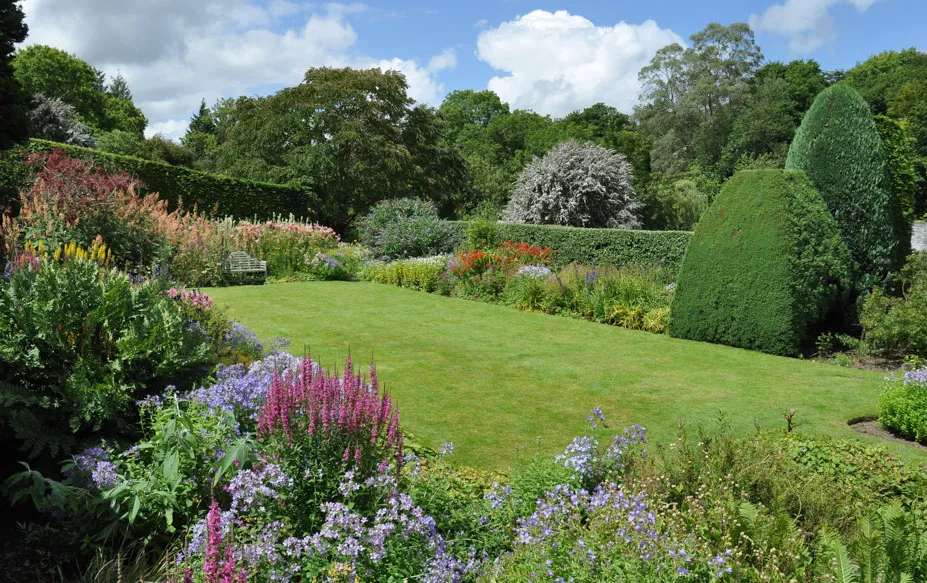Table of Contents
Introduction to Garden Edging
(Gardenedgingexpert.com/blog)
Garden edging plays a crucial role in defining and enhancing the aesthetics of any garden space. Not only does it create clear boundaries between different garden areas, but it also helps in maintaining a neat and organized appearance. Garden edging can prevent the spread of grass and weeds into flower beds, provide a mowing edge, and add a decorative element to your garden. [Gardenedgingexpert.com/blog]
Importance of Garden Edging

The significance of garden edging cannot be overstated. It serves multiple purposes beyond mere aesthetics. Firstly, it helps in maintaining a clean division between different areas of your garden, such as separating the lawn from flower beds or vegetable patches. This separation is essential for effective garden maintenance and plant care. [Gardenedgingexpert.com/blog]
Benefits of Garden Edging

- Aesthetic Appeal: Garden edging adds a finished look to your garden, enhancing its overall visual appeal.
- Weed Control: By creating a physical barrier, edging helps in reducing the spread of weeds into garden beds.
- Ease of Maintenance: It provides a clear line for mowing and reduces the need for frequent trimming.
- Soil Retention: Edging helps in retaining soil and mulch within garden beds, preventing erosion and runoff.
- Improved Plant Health: By separating different garden areas, edging helps in preventing the encroachment of invasive plants.
Overview of Garden Edging
Garden edging comes in various materials, styles, and installation methods. Each type of edging material has its unique set of characteristics, benefits, and potential drawbacks. Understanding these differences is key to selecting the right edging for your garden. [Gardenedgingexpert.com/blog]
Types of Garden Edging

Metal Garden Edging
Advantages:
- Durability: Metal edging is highly durable and can withstand harsh weather conditions.
- Versatility: Available in various styles and finishes, metal edging can suit both modern and traditional gardens.
- Low Maintenance: Requires minimal upkeep compared to other materials.
Installation:
- Mark the desired edging line.
- Dig a trench along the line.
- Place the metal edging into the trench and secure it with stakes.
- Backfill the trench and compact the soil around the edging.
Maintenance:
- Regularly check for rust or damage and treat accordingly to prolong its lifespan.
Plastic Garden Edging
Benefits:
- Cost-Effective: Plastic edging is generally more affordable than other materials.
- Easy to Install: Lightweight and flexible, making it simple to shape and install.
- Durable: Resistant to moisture and pests.
Installation:
- Outline the edging area.
- Dig a shallow trench.
- Place the plastic edging into the trench and anchor it with stakes.
- Fill the trench and tamp down the soil.
Durability:
- Plastic edging can last for many years with minimal maintenance, although it may become brittle over time with exposure to sunlight.
Stone Garden Edging
Types of Stones:
- Natural Stone: Offers a rustic and organic look.
- Cut Stone: Provides a more formal and uniform appearance.
- River Rock: Adds a decorative and textured element to the garden.
Installation Tips:
- Plan the layout and mark the edging line.
- Dig a trench to accommodate the stones.
- Place the stones in the trench, ensuring they are level and stable.
- Fill gaps with soil or mortar, if needed.
Care:
- Regularly inspect for loose stones and reposition them as necessary.
- Clean the stones to prevent moss and algae buildup.
Wood Garden Edging
Types of Wood:
- Cedar: Naturally resistant to decay and insects.
- Redwood: Durable and rot-resistant.
- Pressure-Treated Wood: Treated to resist moisture and pests.
Installation:
- Measure and mark the edging line.
- Dig a trench to fit the wood pieces.
- Place the wood in the trench and secure with stakes.
- Backfill the trench and compact the soil.
Longevity:
- Wood edging can last several years but requires regular treatment to prevent rot and insect damage.
Brick Garden Edging
Styles:
- Traditional Brick: Classic and timeless look.
- Recycled Brick: Eco-friendly and unique.
- Patterned Brick: Adds visual interest with various laying patterns.
Installation Process:
- Outline the edging area and dig a trench.
- Lay a base of sand or gravel for stability.
- Place the bricks in the desired pattern.
- Fill the gaps with sand or mortar.
Upkeep:
- Inspect for loose or shifted bricks and adjust as needed.
- Clean the bricks periodically to maintain their appearance.
Concrete Garden Edging
Designs:
- Pre-Formed Concrete: Ready-made sections for easy installation.
- Poured Concrete: Customizable shapes and designs.
Installation Methods:
- Prepare the site by marking the edging line and digging a trench.
- For pre-formed sections, place them in the trench and secure with stakes.
- For poured concrete, set up forms and pour the concrete mixture.
- Smooth and shape the concrete, then allow it to cure.
Maintenance:
- Concrete edging requires minimal maintenance but may develop cracks over time. Repair any cracks promptly to maintain the edging’s integrity.
Choosing the Right Garden Edging Material
Factors to Consider
- Budget: Determine how much you are willing to spend on edging materials and installation.
- Garden Style: Choose a material that complements the overall design and aesthetic of your garden.
- Durability: Consider the lifespan and maintenance requirements of each material.
- Installation Ease: Some materials are easier to install than others, depending on your DIY skills.
- Environmental Impact: Opt for eco-friendly materials if sustainability is a priority.
Pros and Cons
- Metal: Durable but can be expensive and may rust.
- Plastic: Affordable and easy to install but can become brittle.
- Stone: Natural look but heavy and can be costly.
- Wood: Attractive but requires regular maintenance.
- Brick: Classic appearance but can shift over time.
- Concrete: Long-lasting but can crack and requires professional installation for best results.
DIY Garden Edging Projects
Creative Ideas
- Log Edging: Use cut logs for a rustic and natural look.
- Bottle Edging: Recycle glass bottles for a colorful and unique border.
- Pallet Wood Edging: Repurpose old pallets for an eco-friendly solution.
- Gabion Walls: Fill wire cages with stones for a modern and sturdy edge.
Step-by-Step Guides
- Log Edging:
- Gather logs and cut them to the desired height.
- Dig a trench along the edging line.
- Place the logs vertically in the trench and secure with soil.
- Bottle Edging:
- Collect glass bottles of similar size.
- Dig a trench along the garden border.
- Insert the bottles neck-down into the soil.
- Pack soil around the bottles to secure them.
Professional Garden Edging Services
When to Hire
- Large Projects: For extensive garden areas or complex designs.
- Specialized Materials: When using materials that require professional handling and installation.
- Time Constraints: If you lack the time or skills to complete the project yourself.
What to Expect
- Initial Consultation: Discuss your vision, budget, and material preferences with the professional.
- Design Proposal: Receive a detailed plan and cost estimate.
- Installation: Professionals will handle all aspects of the installation process.
- Follow-Up: Ensure satisfaction and address any concerns post-installation.
Garden Edging Installation Tips
Tools Needed
- Shovel
- Garden Hose or String (for marking lines)
- Stakes and Mallet
- Level
- Edging Spade
- Hammer or Rubber Mallet
- Tape Measure
Common Mistakes to Avoid
- Incorrect Measurements: Always double-check measurements before starting.
- Poor Preparation: Ensure the ground is well-prepared and level before installation.
- Ignoring Drainage: Consider water flow and drainage to prevent waterlogging.
- Skipping Maintenance: Regularly inspect and maintain your edging to ensure its longevity.
Maintaining Your Garden Edging
[Gardenedgingexpert.com/blog]
Seasonal Care
- Spring: Inspect for damage from winter and clean the edging.
- Summer: Ensure edging is secure and trim any overgrowth.
- Fall: Prepare edging for winter by securing loose sections and removing debris.
- Winter: Protect edging from harsh weather if necessary.
Repair Tips
- Loose Stones: Reposition and secure with soil or mortar.
- Cracked Concrete: Fill cracks with a suitable filler to prevent further damage.
- Damaged Wood: Replace rotten sections and treat with a wood preservative.
Innovative Garden Edging Ideas
[Gardenedgingexpert.com/blog]
Unique Designs
- Glow-in-the-Dark Edging: Use glow-in-the-dark stones or paint for a striking nighttime effect.
- Mosaic Edging: Create colorful patterns with broken tiles or glass.
- Living Edging: Plant low-growing, hardy plants like thyme or sedum along the border.
- Repurposed Materials: Use old roofing tiles, plates, or other household items for a quirky edge.
Custom Projects
- Integrated Lighting: Install solar lights along the edging for added ambiance.
- Water Features: Incorporate small fountains or water channels within the edging design.
- Themed Borders: Match the edging to the theme of your garden, such as a fairy tale or Zen garden.
Eco-Friendly Garden Edging Options
[Gardenedgingexpert.com/blog]
Sustainable Materials
- Recycled Plastic: Made from post-consumer waste, reducing landfill impact.
- Bamboo: A fast-growing, renewable resource that is durable and attractive.
- Reclaimed Wood: Repurposing old wood reduces the demand for new timber.
Benefits
- Environmental Impact: Using sustainable materials helps reduce your garden’s carbon footprint.
- Cost Savings: Some eco-friendly options, like reclaimed materials, can be more affordable.
- Aesthetic Appeal: Many sustainable materials offer unique and attractive appearances.
Cost of Garden Edging
[Gardenedgingexpert.com/blog]
Budgeting
- Material Costs: Prices vary widely depending on the material chosen. For example, plastic edging is generally cheaper than stone or metal.
- Installation Costs: Professional installation can add to the overall expense but ensures a high-quality finish.
- Maintenance Costs: Consider the long-term maintenance requirements and costs of each material.
Cost-Effective Options
- Plastic Edging: Affordable and easy to install.
- Reclaimed Materials: Often available at a lower cost or even for free.
- DIY Projects: Save on labor costs by installing the edging yourself.
Garden Edging for Different Landscapes
[Gardenedgingexpert.com/blog]
Sloped Areas
- Use flexible materials like plastic or metal that can contour to the slope.
- Consider terracing with stone or wood to create level planting areas.
Rocky Areas
- Stone edging blends well with rocky landscapes and provides stability.
- Use metal edging to navigate around larger rocks and boulders.
Wet Areas
- Choose materials resistant to moisture, such as plastic or concrete.
- Ensure proper drainage to prevent water accumulation around the edging.
Garden Edging TrendsLatest Styles
[Gardenedgingexpert.com/blog]
- Minimalist Edging: Sleek, simple lines with modern materials like metal or concrete.
- Naturalistic Edging: Blends seamlessly with the garden using natural materials like stone or wood.
- Geometric Patterns: Bold, structured designs that add a contemporary flair.
Popular Materials
- Corten Steel: Rusted metal with a weathered look that adds character.
- Gabion Walls: Wire cages filled with stones for a modern, industrial appearance.
- Recycled Materials: Eco-friendly and often unique, adding a personal touch.
Garden Edging Safety Tips
[Gardenedgingexpert.com/blog]
Avoiding Hazards
- Ensure all edging materials are securely installed to prevent tripping hazards.
- Use smooth, rounded edges to minimize the risk of injury.
- Keep tools and materials organized during installation to avoid accidents.
Ensuring Stability
- Properly compact the soil around the edging to ensure it remains stable.
- Regularly inspect and maintain the edging to address any issues promptly.
- Use appropriate fasteners and anchors for the chosen material to enhance stability.
Frequently Asked Questions About Garden Edging
[Gardenedgingexpert.com/blog]
What is the best material for garden edging?
The best material depends on your specific needs, including budget, aesthetic preferences, and maintenance requirements. Popular options include metal for durability, stone for a natural look, and plastic for affordability.
How do I install garden edging?
The installation process varies by material but generally involves marking the edging line, digging a trench, placing the edging material, and securing it with soil or stakes. Detailed installation guides are available for each material.
How much does garden edging cost?
Costs vary widely depending on the material and whether you opt for professional installation. Budget options like plastic edging can be inexpensive, while premium materials like stone or metal may be more costly.
Can I install garden edging myself?
Yes, many types of garden edging can be installed as DIY projects. Ensure you have the necessary tools and follow installation guidelines for the best results.
How do I maintain garden edging?
Regular maintenance includes inspecting for damage, cleaning the edging, and making any necessary repairs. Specific care tips depend on the material used.
Is garden edging eco-friendly?
Eco-friendly options are available, such as recycled plastic, reclaimed wood, and sustainable materials like bamboo. These choices help reduce your garden’s environmental impact.
Conclusion [Gardenedgingexpert.com/blog]
[ Gardenedgingexpert.com/blog] Garden edging is a vital component in creating a well-maintained and visually appealing garden. From selecting the right material to understanding installation and maintenance, this comprehensive guide covers everything you need to know. Whether you’re looking for DIY projects or professional services, garden edging can transform your outdoor space into a beautifully defined and organized area.











